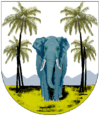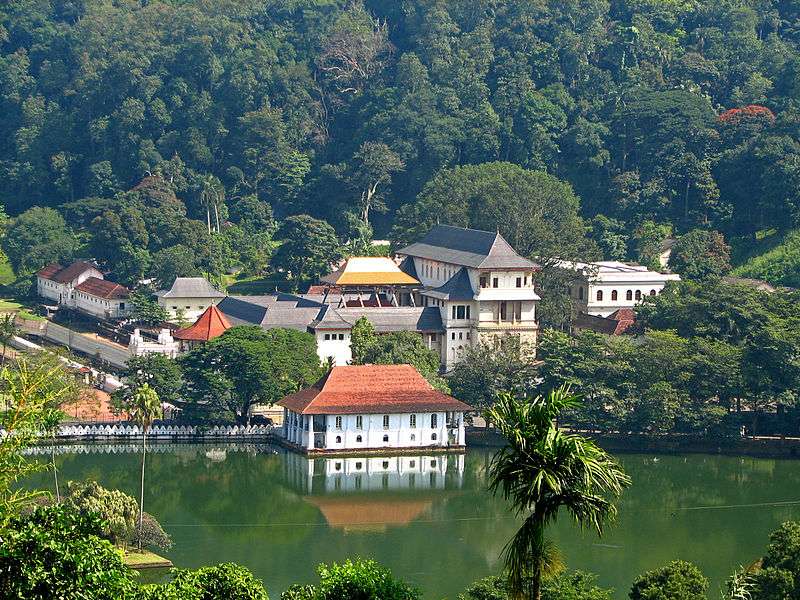Portuguese Ceylon
| Portuguese Ceylon | |||||||||||
|---|---|---|---|---|---|---|---|---|---|---|---|
| 1597–1658 | |||||||||||
.svg.png) Flag
 Coat of arms
| |||||||||||
 Extent of Portuguese rule in Ceylon | |||||||||||
| Status | Portuguese colony | ||||||||||
| Capital | Colombo | ||||||||||
| Common languages |
Portuguese Sinhalese Tamil | ||||||||||
| Religion | Roman Catholicism | ||||||||||
| King of Portugal | |||||||||||
• 1597–1598 | Philip I | ||||||||||
• 1598–1621 | Philip II | ||||||||||
• 1621–1640 | Philip III | ||||||||||
• 1640–1656 | John IV | ||||||||||
• 1656–1658 | Afonso VI | ||||||||||
| Governors | |||||||||||
• 1597–1614 | Jerónimo de Azevedo | ||||||||||
• 1656–1658 | António de Amaral de Meneses | ||||||||||
| Historical era | Colonialism | ||||||||||
• Portuguese arrival | 1505 | ||||||||||
• Death of Dharmapala of Kotte | 27 May 1597 | ||||||||||
• Luso–Kandyan Treaty | 1633 | ||||||||||
• Surrender of Jaffna | June 1658 | ||||||||||
| |||||||||||
| Today part of |
| ||||||||||
Portuguese Ceylon (Portuguese: Ceilão Português, Sinhala: පෘතුගීසි ලංකාව Puruthugisi Lankawa) was the control of the Kingdom of Kotte by the Portuguese Empire, in present-day Sri Lanka, after the country's Crisis of the Sixteenth Century and into the Kandyan period.
The Portuguese presence in the island lasted from 1505 to 1658. Their arrival was largely accidental, as they sought control of commerce, rather than territory. Their appearance coincided with the political upheaval of the Wijayaba Kollaya, and they were drawn into the internal politics of the island as they sought to establish control over the lucrative cinnamon trade that originated there. The Portuguese used these internal divisions to their advantage during the Sinhalese–Portuguese War. Direct Portuguese rule inside the island did not begin until after the death of Dharmapala of Kotte, who died without an heir. He bequeathed the Kingdom of Kotte to the Portuguese monarch in 1580.[1] That allowed the Portuguese sufficient claim to the Kingdom of Kotte upon Dharmapala's death in 1597. Portuguese rule began with much resistance by the local population.[2]
Eventually, the Kingdom of Kandy sought help from the Dutch Empire in their efforts to rid the island of the Portuguese. The Dutch Empire initially entered into agreement with the Kingdom of Kandy. After the collapse of the Iberian economy in 1627, the Dutch–Portuguese War saw the Dutch conquest of most of Portugal's Asian colonies. Eventually, Portugal's Ceylonese territories were ceded to the Netherlands. Nevertheless, elements of Portuguese culture from this colonial period remain to this day, in Sri Lanka.
Part of a series on the |
|---|
| History of Kandy |
 |
| Kingdom of Kandy (1469–1815) |
| Colonial Kandy (1815–1948) |
| Kandy (1948–present) |
| See also |
|
|
History
The first contact between Sri Lanka and the Portuguese happened in 1505-6. It was largely accidental and it wasn't until 12 years later that the Portuguese sought to establish a fortified trading settlement.[3]
Jaffna kingdom–Portuguese War
Sinhalese–Portuguese War
Portuguese rule
Direct Portuguese rule began after the death of Dharmapala of Kotte who bequeathed the Kingdom of Kotte to the Portuguese monarch.[4] By 1600 the Portuguese had consolidated the main centers of rebellion, the Kelani and Kalu ganga basins, leaving the border regions to Sinhalese resistance.[5]
- Revolts
In the two decades after the establishment of Portuguese rule there were four major revolts:[6]
- Kangara arachchi Revolt, 1603
- 1st Kuruvita rala Revolt, 1603
- 2nd Kuruvita rala Revolt, 1616–19
- Nikapitiye Bandara Revolt, 1616–17
Dutch–Portuguese War
Administration
Portuguese Captains (1518–1551)
Portuguese Captain-majors (1551–1594)
Portuguese Captain-generals (1594–1658)
See also
References
Bibliography
- De Silva, K. M. (1981). A History of Sri Lanka. India: University of California Press. ISBN 0-520-04320-0.
- C. Gaston Pereira, Kandy fights the Portuguese. Sri Lanka: Vijitha Yapa Publications, July 2007. ISBN 978-955-1266-77-6
- Channa Wicremasekera, Kandy at War. Sri Lanka: Vijitha Yapa Publications, 2004. ISBN 955-8095-52-4
- Michael Roberts, Sinhala Consciousness in the Kandyan Period. Sri Lanka: Vijitha Yapa Publications, 2004. ISBN 955-8095-31-1,
- Abeysinghe, Tikiri (2005). Jaffna under the Portuguese. Colombo: Stamford Lake. p. 66. ISBN 955-1131-70-1.
- Kunarasa, K (2003). The Jaffna Dynasty. Johor Bahru: Dynasty of Jaffna King’s Historical Society. p. 122. ISBN 955-8455-00-8.
- Gnanaprakasar, Swamy (2003). A Critical History of Jaffna (review of Yalpana Vaipava Malai). New Delhi: Asian Educational Services. p. 122. ISBN 81-206-1686-3.
- Senaka Weeraratna, Repression of Buddhism in Sri Lanka by the Portuguese (1505–1658)
